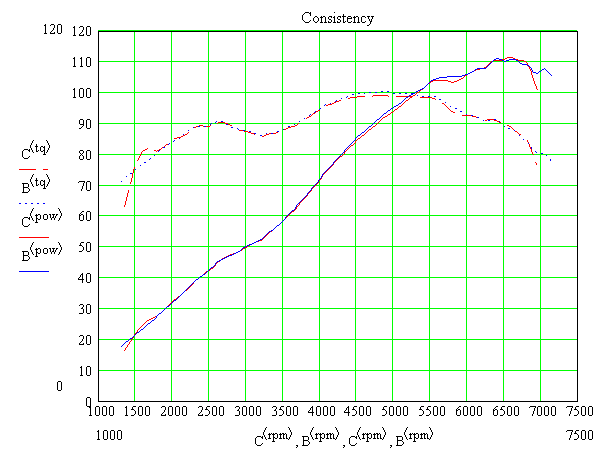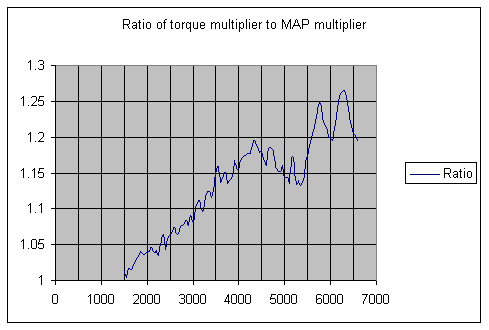Jason's website | home
My software dyno | Initial dyno results of TEC-II, NA, then turbo | 1.6 and "95hp" NA tuning | my former Greddy setup | DIY 2001 braces | fuelling circuit for M1's | AVO turbo install | Shiv's fuel rail yields 265 hp | 280hp dyno tuning by Shiv on Scott's 1.8
<This link's target cannot be found>
Initial dyno results of TEC-II, NA, then turbo
To jump to turbo results, click here.
December 2000
The TEC-II just went into my 2000 Miata, which is otherwise bone-stock. This is in preparation for a turbo. Click here (photopoint site) for pictures.
The TEC-II is a programmable aftermarket ECU:
I used my dyno software, which logs ignition pulses vs time while accelerating on a flat road in 2nd gear from a low rpm to revlimit.
NOTE: All dyno runs below are done in 2nd gear. Dynojet runs are done in 4th. 2nd gear loses 10 ft-lbs and 7 hp compared to 4th gear, as tested on a Dynojet. 4th gear (in a 5 spd) has least losses because it is 1:1 ratio.
My software dyno assumes a certain weight, tire and aerodynamic losses. I have tweaked these values in my program to make my stock dyno run match up with an actual Dynojet run (at bottom of this page).
So to get equivalent 4th gear dynojet readings, add 10 ft-lbs and 7 hp to the peak values.
I did 2 runs to check consistency, with the TEC in place.

Correction factor used = 0.97
Hmm, this is plenty good enough to spot differences. About +/- 1 ftlb and 1 hp through most of the range. The difference in the low end, below 2000 rpm is that I jumped on the gas at slightly different RPMs, and the difference in the top-end is that in run C, I lifted before hitting the revlimiter. Admittedly, the 300 rpm higher revlimit makes me a wee bit uncomfortable - the engine sounds extra strained in those last 300 rpm.
Now here is the comparison before and after the TEC:

Correction = 0.97. BTW You can see the brief drop in torque when the VICS kicks in at 5550 rpm - it shows up at a higher RPM in 2nd gear because it has a slight lag. In 4th gear it kicks in at 5250 rpm. VICS is the variable intake runner length thing which switches improves the top-end.
Pretty good. That's around 8 more hp and 7 more ft-lbs, with gains everywhere save for a small dip at 3250 rpm. And this is with Shiv's map (for his supercharged wonder) that hasn't been tuned for my particular engine yet. Maybe I'll try tuning that dip out.
BTW this TEC run had a correction factor of .97 because the ambient temperature was 12 deg C.
So an equivalent dynojet run would be around 117 hp pk and 110 ft-lbs.
Here is my dynojet run while stock. The upper two readings are successive 4th gear runs to check consistency. The lower reading is 2nd gear.
Try comparing the 2nd gear data with my above stock run. See also VICS dip.

March 2001
Installed AVO turbo with small Garrett ball-bearing turbo option. Dynoed below in 2nd gear, after some minor tuning. The TEC's ignition and fuel map is still very close to Shiv's supercharged car, with minor tweaks to the raw fuel curves. For now I still have the stock exhaust. I expect a gain of at least 10% with a large exhaust. On the road the turbo is very responsive, very driveable, and spools up a lot quicker than my ex-Greddy turbo.
Here is my extracted torque and power plots using my software: The lower plot was when bone-stock with the factory ECU. This plot also has approximate correction to get dynojet 4th gear equivalents (107hp, stock)

A comment: the oscillation at hi RPM is an artifact of the smoothing algorithm and the audio sampling rate of 44.1 kHz on the factory ECU ignition signal. It happens now with the turbo because RPMs rise so quickly. To increase resolution I have to log 3rd gear runs, use an audio recorder with a higher sampling rate, or us a higher resolution signal, like the TEC's 60-tooth trigger wheel signal. So that's probably ~175 hp peak.
Boost is purely wastegate controlled for now, and I get an overshoot to 8 psi at close to 4000 rpm, and slight oscillation (but not the same oscillation as the torque plot below). The oscillation is because the wastegate pickup sense point is after the intercooler, so there is "control phase lag" or "transport lag" in the intercooler (totally unrelated to "turbo lag"). Below plot is in 2nd gear. In 4th gear, the rising torque characteristic would come at least 500 rpm sooner.
The below plot is % gain over the bone-stock plots with the factory ECU, which dynoed at 107 hp on a dynojet. I used % gain for now because It gives a good indication of tuning. +65% increase at 7 psi, with the stock exhaust, is pretty good.

This is the boost curve of that run. 4th gear would probably show boost 500 rpm sooner.

Excuse the following rough plot. This is the ratio of torque gain to manifold pressure increase. (new torque/stock torque) / (new manifold pressure/1 atmosphere). It shows how much more torque per psi of absolute manifold pressure I'm getting, vs. stock. For example, at the topend, I'm getting 22% more
torque per MAP value than while I was NA.
The fact that it's >1 means either the engine is working more efficiently or the drivetrain losses decreased, or both. I think somehow the engine runs more efficiently with boost, so that's how Shiv got 280 wheel hp at 14 psi of boost, from a motor that normally shows 103hp while stock.
